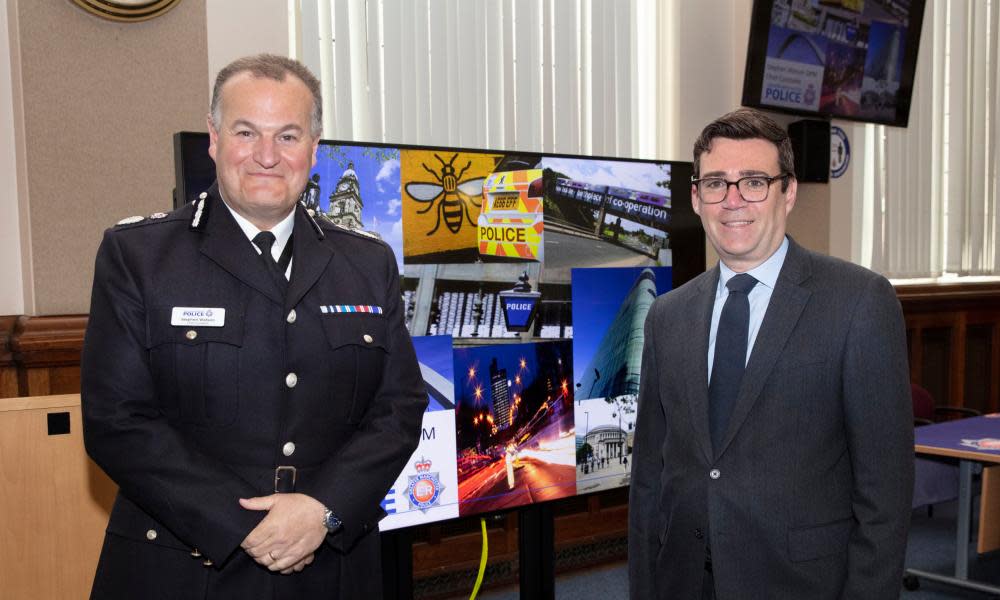Manchester police chief rejects claim of institutional racism

The head of one of England’s biggest police forces has rejected the claim it is “institutionally racist”, despite findings that its officers are five times more likely to stop and search black people than their white counterparts.
The Achieving Race Equality report by Greater Manchester police (GMP) also found that black people were four times more likely to have force used against them in the region, and that GMP officers were more likely to refer to the physique of black people when recording why they used force – proof a “racist trope” is being used in policing, according to the region’s race equality chair.
The report, commissioned by the mayor of Greater Manchester, Andy Burnham, also found that black and minority ethnic people were underrepresented in the force.
Only 980 (8.4%) of GMP’s 11,700-strong workforce are of BAME heritage, compared with 15% of the economically active local population. Black people are particularly underrepresented among GMP’s officers and police staff.
Elizabeth Cameron, the chair of the Greater Manchester Race Equality panel, said disproportionality identified in the report went beyond unconscious bias and “into the realms of racism”.
Black people were 5.7 times more likely than white people to have had a stun gun used against them by GMP – less than the national average of nine times more likely. Asian people were no more likely than white people to have a stun gun used against them, but those recorded as in the “other and unknown ethnicity group” (which includes Chinese, Japanese or other south-east Asian, north African or Arab or any other ethnicity) were 7.7 times more likely.
“I would unequivocally say that there is institutional racism [in GMP],” said Cameron. “There are an inherent attitudes there – the speed at which people trigger towards aggression is what proves it.”
Stephen Watson, who became the chief constable of GMP in May, rejected Cameron’s claim.
“Do I think GMP is institutionally racist? My answer would be no, I don’t think that. I do not for one second deny that in an organisation which is the thick end of 12,000 people-strong, we may actually find ourselves from time to time employing somebody who behaves in a racist way, who commits offences,” he said, insisting that when such officers were unmasked, “we root them out, and we boot them out”.
He added: “I do not accept that GNP is institutionally racist, but I do accept that a lot of people think we are. And their view is really important because they are the folks that we serve, and so we have to address those concerns head on.”
Related: MPs and campaigners alarmed at UK’s ‘discriminatory’ crime reduction plans
The report suggested officers sometimes treated racial groups differently. The authors write: “It seems likely to be significant that police officers are more likely to refer to the physique of Black people when recording the use of force impact factors – in relation to which a key question may well be whether there may be biases in relation to officers’ decision making.”
Cameron said that observation was proof “racist tropes” were being used to justify force against black people. It showed, she said, that there were officers “who fashion their ideas on a stereotype that they contain in their head of what a Black man means, and what a Black man is going to do, before they even get a chance to do it”.
Watson accepted that the recording of black people’s physique could imply “that officers are using almost stereotypical tropes in describing a dynamic”. But he stressed that the report “doesn’t provide all of the answers”.
He said the force needed to work harder to recruit a more representative workforce. The report found that while GMP had made “good progress” in recruiting more Asian people, it had struggled to entice black people into the force.
There are 111 officers, staff and PCSOs with Black/African/Caribbean/Black British backgrounds, compared with 93 in 2014. By comparison, the number of Asian people on the force had grown from 259 to 592 in the same period.

 Yahoo Movies
Yahoo Movies 
